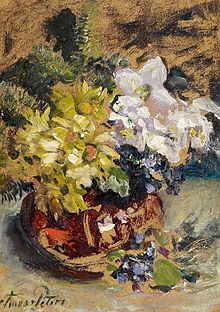Anna Peters (painter)

Anna Peters (born February 28, 1843 in Mannheim , † June 26, 1926 in Stuttgart ) was a German flower , still life and landscape painter . As one of the first women in Germany, she worked as a painter and was able to make a living from selling her pictures.
Life
Anna Peters was born on February 28, 1843 as the daughter of the Dutch landscape painter Pieter Francis Peters (1818–1903) and his wife Heinrike (Heinrika?) Gertrude Mali (? –1884) in Mannheim. Her grandfather Peters had already worked as a glass painter in Nijmegen . Her mother was a sister of Christian Mali , an animal painter from the Munich school , who was accepted into his sister's family with his brothers in 1845 after the death of his parents. In 1845 the Peters family moved to Stuttgart, where Anna Peters lived with her sisters until her death. She remained unmarried. She received from her father Pieter Francis Peters, her younger sisters Pietronella Peters (1848–1924) and Ida Peters as well as their ten years older uncle Christian Mali and his brothers Johannes Cornelis Jacobus Mali (1828–1865) and Hubertus Mali (1818–1839, drowned in the Ahr) the first painting lesson. Later she was further taught and influenced by Christian Mali and maintained close artistic contact with him throughout her life.
Anna Peters stayed with her family from 1894 to 1904 every year and at irregular intervals from 1907 to 1924 in the summer at Castle Köngen, southeast of Stuttgart, to do artistic work. In addition to pictures of flowers, there were also village views and landscapes. Christian Mali and his artist friend Anton Braith were present several times during these stays .
She also undertook several artistic trips where she got inspiration for her flower and landscape paintings, including to Lake Constance and the Black Forest and the Thuringian Forest , to Biberach an der Riss , Interlaken , Zurich , Nijmegen , Rome , Florence and Milan , and she accompanied Mali and Braith on their study tours to South Tyrol .
She spent the last years of her life from 1912 with her sisters in their own house in Stuttgart-Sonnenberg, where she died on June 26, 1926. Anna-Peters-Strasse is named after her there.
plant
Anna Peters ’work includes drawings , watercolors and oil paintings . Your first well-known picture dates from 1860 and shows an autumn bouquet . The focus of her work was still on the representation of flowers and plants from her environment, which she occasionally garnished with insects . In this respect, it was in the tradition of Dutch flower painting. In addition, she repeatedly worked on landscape paintings and still lifes. There are also a few pictures of her children, but she did not want to compete with her sister Pietronella. According to the prevailing opinion at the time, women painters were only appropriate for such motifs. B. History painting , mythological and religious scenes should be reserved for men.
At the end of the 1890s, Anna Peters developed a more impressionistic painting style from the strictly realistic imagery of her first artist years .
She regularly took part in exhibitions, from 1896 also outside of Stuttgart, z. B. in Berlin , Munich , Dresden and Vienna .
Economic success
Anna Peters was already running the family business at the age of 26, including those of her father and sister, and cultivated diverse relationships with the art trade in several cities. She marketed her pictures very successfully so that she could make a living from them. During her lifetime her paintings cost an average of between 300 and 400 marks; For her picture of autumn flowers in 1878 even 800 marks were asked for. Today her paintings have a market value of several thousand euros. According to Artprice , around 230 of her works changed hands between 1989 and 2006. Many of her pictures are in private hands. On Schloss Köngen there is a sizable collection of works of Peter's family, as well as in Braith-Mali Museum in Biberach.
Professional engagement
Anna Peters had been a member of the professional association of female artists in Berlin since 1880 . She was a co-founder of the Württemberg painters' association , which she chaired from 1893 to 1902 and 1904 to 1919. This association was women over 18 years open, the visual arts or crafts professionally exercised, and had the manner of a professional association own loans and provident fund established. He also organized exhibitions and conducted social activities. In doing so, he tried to overcome reservations about female painters at the time and gain social recognition for them.
Honors
In 1918 she was awarded the Gold Medal for Art and Science from the Kingdom of Württemberg .
literature
- Monika Machnicki: Anna Peters . Foreword to the catalog for the exhibition Anna Peters 1843–1926 in the Braith Mali Museum in Biberach an der Riss, 1990, ISBN 3-924392-13-7
- Maja Riepl-Schmidt : Anna Peters. A “painter” from the very beginning . In: Maja Riepl-Schmidt (Hrsg.): Against the overcooked and ironed out life. Women's emancipation in Stuttgart since 1800 . Silberburg, Stuttgart 1990, ISBN 3-925344-64-0 , p. 113-123 .
- Herbert Hoffmann, Kurt Diemer: Catalog of paintings and sculptures . Braith-Mali-Museum, Biberach an der Riss, 1975
- On the 125th birthday of Anna Peters , in: Official Gazette of the City of Stuttgart No. 8 of February 28, 1968
- Anna Peters in memory , in: Süddeutsche Zeitung. Enclosed: Sunday No. 30 of July 25, 1926
- Obituary for Anna Peters , in: Stuttgarter Neues Tagblatt from June 29, 1926
Web links
| personal data | |
|---|---|
| SURNAME | Peters, Anna |
| BRIEF DESCRIPTION | German flower, still life and landscape painter |
| DATE OF BIRTH | February 28, 1843 |
| PLACE OF BIRTH | Mannheim |
| DATE OF DEATH | June 26, 1926 |
| Place of death | Stuttgart |

